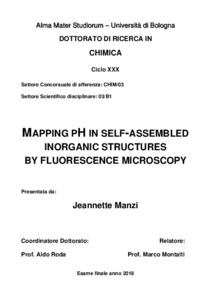Manzi, Jeannette
(2018)
Mapping pH in self-assembled inorganic structures by fluorescence micriscopy, [Dissertation thesis], Alma Mater Studiorum Università di Bologna.
Dottorato di ricerca in
Chimica, 30 Ciclo. DOI 10.6092/unibo/amsdottorato/8383.
Documenti full-text disponibili:
![[img]](http://amsdottorato.unibo.it/8383/1.hassmallThumbnailVersion/Manzi_Jeannette_tesi.pdf)  Anteprima |
|
Documento PDF (English)
- Richiede un lettore di PDF come Xpdf o Adobe Acrobat Reader
Disponibile con Licenza: Salvo eventuali più ampie autorizzazioni dell'autore, la tesi può essere liberamente consultata e può essere effettuato il salvataggio e la stampa di una copia per fini strettamente personali di studio, di ricerca e di insegnamento, con espresso divieto di qualunque utilizzo direttamente o indirettamente commerciale. Ogni altro diritto sul materiale è riservato.
Download (9MB)
| Anteprima
|
Abstract
We detected local pH changes in real time during formation of inorganic self-assembled systems by wide field and confocal fluorescence microscopy. The aim was to identify and characterize fluorescent probes that can work in specific pH ranges in peculiar conditions, such as presence of concentrated metal ions. We had also to re-design the crystallization setup reported in literature to make it compatible with the observation in fluorescence microscopy. Three kinds of systems have been studied, for which different specific experimental approaches have been developed: calcium biomorphs in silica gel that form calcite and aragonite stripes, barium biomorphs in silica gel, and silica gardens.
A ratiometric method for mapping pH in silica gel-grown biomorphs during diffusion of calcium and barium was developed, so that it was possible to correlate the morphogenetic process to the local pH changes. We concluded that biomorphs formation starts at very specific pH values and their growth occurs in a pH gradient in a diffusional regime. Differently from sol-grown biomorphs, any localized and oscillating changes of pH in proximity of the front of growth of the biomorphs were not detected. This result suggests that the properties of the matrix (e.g. silica sol vs. gel, thickness) are very critical in determining possible accumulation of chemical species around biomorphic structures.
About silica gardens, we could observe locally and in real time precipitation/re-dissolution processes, resulting from diffusion of chemical species through the membrane formed at the interface between metal and silicate solutions, which were analyzed in detail and whose possible chemical mechanisms were proposed. Thanks to fluorescence based pH mapping of growing silica gardens in a quasi 2D regime, the tubular membrane growth was for the first time demonstrated to involve formation of jet (even in the absence of buoyancy) where actual mixing of the metal and silicate solutions occurs.
Abstract
We detected local pH changes in real time during formation of inorganic self-assembled systems by wide field and confocal fluorescence microscopy. The aim was to identify and characterize fluorescent probes that can work in specific pH ranges in peculiar conditions, such as presence of concentrated metal ions. We had also to re-design the crystallization setup reported in literature to make it compatible with the observation in fluorescence microscopy. Three kinds of systems have been studied, for which different specific experimental approaches have been developed: calcium biomorphs in silica gel that form calcite and aragonite stripes, barium biomorphs in silica gel, and silica gardens.
A ratiometric method for mapping pH in silica gel-grown biomorphs during diffusion of calcium and barium was developed, so that it was possible to correlate the morphogenetic process to the local pH changes. We concluded that biomorphs formation starts at very specific pH values and their growth occurs in a pH gradient in a diffusional regime. Differently from sol-grown biomorphs, any localized and oscillating changes of pH in proximity of the front of growth of the biomorphs were not detected. This result suggests that the properties of the matrix (e.g. silica sol vs. gel, thickness) are very critical in determining possible accumulation of chemical species around biomorphic structures.
About silica gardens, we could observe locally and in real time precipitation/re-dissolution processes, resulting from diffusion of chemical species through the membrane formed at the interface between metal and silicate solutions, which were analyzed in detail and whose possible chemical mechanisms were proposed. Thanks to fluorescence based pH mapping of growing silica gardens in a quasi 2D regime, the tubular membrane growth was for the first time demonstrated to involve formation of jet (even in the absence of buoyancy) where actual mixing of the metal and silicate solutions occurs.
Tipologia del documento
Tesi di dottorato
Autore
Manzi, Jeannette
Supervisore
Dottorato di ricerca
Ciclo
30
Coordinatore
Settore disciplinare
Settore concorsuale
Parole chiave
biomorphs, silica gardens, fluorescence microscopy, wide field fluorescence microscopy, confocal fluorescence microscopy, FLIM, pH, pH probe, acridine, HPTS
URN:NBN
DOI
10.6092/unibo/amsdottorato/8383
Data di discussione
9 Maggio 2018
URI
Altri metadati
Tipologia del documento
Tesi di dottorato
Autore
Manzi, Jeannette
Supervisore
Dottorato di ricerca
Ciclo
30
Coordinatore
Settore disciplinare
Settore concorsuale
Parole chiave
biomorphs, silica gardens, fluorescence microscopy, wide field fluorescence microscopy, confocal fluorescence microscopy, FLIM, pH, pH probe, acridine, HPTS
URN:NBN
DOI
10.6092/unibo/amsdottorato/8383
Data di discussione
9 Maggio 2018
URI
Statistica sui download
Gestione del documento:


 Login
Login
